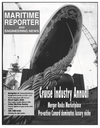
Page 48: of Maritime Reporter Magazine (July 1997)
Read this page in Pdf, Flash or Html5 edition of July 1997 Maritime Reporter Magazine
by David Tinsley, technical editor
FINCANTIERI ... ... Closer focus on niche markets
Italy's contribution to European shipbuilding activity tends to be understated, partly because of his- toric rivalries and often outmoded perceptions within Europe itself.
But the dynamism of the industry in Italy cannot be disputed, mir- rored in the far-reaching restruc- ture of the state-owned sector and its forceful assertion in growth areas of the international market.
On the equipment manufactur- ing side, Italy's share of the busi- ness has contracted in the past 10 years. Yet, during what has been an exceedingly difficult period for
European shipbuilders as a whole,
Italy has retained traditional craft and technology skills, as well as outfitting strengths.
A characteristic flair for interior design — from which Italy's renaissance in passenger ship con- struction and refitting has benefit- ed — complements the nation's technical and engineering know- how, which is now supported by microprocessor-based computa- tional and analytical tools.
While state-owned Fincantieri has enjoyed a remarkable financial turnaround in recent years, and now has hard-earned prominence in the cruise ship sector with an unmatched 40-plus percent market share in terms of gross tonnage,
Chairman and CEO Corrado
Antonini said there is no room for complacency.
An evolving market situation poses new challenges for the future, and even in the niche area of large, luxury passenger ship construction, the competitive pres- sures are intensifying. Quality, delivery and contractual perfor- mance are the guiding principles in a market where customer expec- tations have risen steadily.
Central to long-term success in the market, said Dr. Antonini, are project management skills, which have been continuously honed at the Monfalcone and Venice-
Marghera yards since the group returned to the large passenger ship field in the mid-1980s.
Fincantieri has secured contracts since that time for a total of 21 cruise ships, to an aggregate value of more than Lire 11,000 billion.
With 10 capital vessels delivered in the last seven years, the orderbook for the remaining 11 newbuildings is worth more than Lire 6,500 bil- lion. The new era was signaled by the seminal 70,000-gt sisters
Crown Princess and Regal
Princess, originally ordered by
Sitmar and delivered to P&O
Princess Cruises in 1990/91.
The float-out in May of the 85,000-gt Disney Magic marked an important juncture for the ship- builder, given the enormous tech- nical and project management demands of the two-ship Disney contract, and the value-intensity and strategic, commercial signifi- cance of the project to the cruise line.
While success has been enjoyed,
Dr. Antonini warned that the restructuring process has to con- tinue, to ensure that the group is best equipped to cope with the market situation. Changes already effected include a substan- tial reduction in the payroll, the sale of most of the repair yards to the private sector and the adapta- tion of the naval yards to facilitate a large-scale entry into the fast ferry market.
Fincantieri has strived to main- tain a diversified business approach whereby steel-intensive ^TTI Integrated Ship Production
Windows 951 NT Project Management Scheduling
Bill of Materials
Albacore Research Ltd. 3080 Uplands Rd„ Victoria, B.C., Canada, V8R 6B4 Tel: (1-250) 595-0576 Fax: (1-250) 721-3433 E-mail: [email protected]
Circle 205 on Reader Service Card ships such as Aframax and
Suezmax crude carriers and
Panamax and larger bulkers have complemented production of ship types with a higher capital concen- tration. However, Corrado
Antonini believes that the compa- ny will have to become more selec- tive in its product range, and devote itself to a greater extent to niche markets.
Long an advocate of regional short sea shipping, he believes that
Europe can offer expanding oppor- tunities for RoRo ferries and other efficient forms of sea transporta- tion as part of a modal shift of freight from the road system to coastal routes.
Fincantieri continues to target new opportunities in the cryogenic tanker sector, where it maintains an actual production presence, as currently expressed in the con- struction of a 65,000-cu-m LNG carrier for SNAM.
The recent delivery, in quick suc- cession, of monohull fast ferries
SuperSeaCat One, Pegasus Two and SuperSeaCat Two, highlights the group's level of commitment to the fast ferry sector. Forced to deal with reduced Italian defense spending, contractual success in the commercial field has meant that at least 50 percent of the activity of Fincantieri's naval ship division is accounted for by high- speed ferry design and construc- tion. Another 20-25 percent of the division's business is generated by the mechanical products division, such that the actual warship build- ing operation is down to less than 25 percent of activity.
The current program of MDV- series monohull vessels, employing both steel and aluminum alloy 50 Maritime Reporter/Engineering News

 47
47

 49
49
